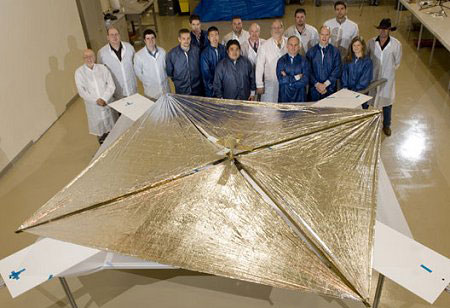NASA Solar Sail Satellite Ejects from Mothership in Space

A small NASA satellite carrying afolded-up solar sailejected from its mothership in low-Earth orbit Monday (Dec. 6),marking akey success in NASA's efforts to develop and deploy solar-sailtechnology.
NanoSail-D, which is about the sizeof a loaf of bread,ejected from NASA's washing-machine-sized FASTSAT satellite at 1:31a.m. EST(0631 GMT) Monday.
NanoSail-D's 100-square-foot sail isstill folded up tightfor now. It should unfurl in about two days, demonstrating atechnology thatNASA hopes will help bring decommissioned satellites down from Earth'sorbit withoutusing up valuable propellant. The idea is to use radiation from the sunas a sortof wind pushing against a thin sail to propel the lightweight craftthroughspace. [Pictureof NanoSail-D satellite.]
"This is a great step for our solarsail team with thesuccessful ejection of the NanoSail-D satellite from FASTSAT," DeanAlhorn, NanoSail-D principal investigator and aerospace engineer atNASA'sMarshall Space Flight Center in Huntsville, Ala., said in a statement.
Doing things differently
Nanosatellites, also known as cubesats,are typically launched and deployed from a mechanism that mountsdirectly on alaunch vehicle. This is the first time NASA has mounted this mechanismon amicrosatellite to eject a cubesat, agency officials said.
FASTSAT ? short for Fast, Affordable,Science and TechnologySatellite ? launchedNov. 19 from Kodiak Island, Alaska, bearing six differentscience andtechnology demonstration payloads, including NanoSail-D.
Get the Space.com Newsletter
Breaking space news, the latest updates on rocket launches, skywatching events and more!
"The successful ejection ofNanoSail-D demonstrates theoperational capability of FASTSAT as a cost-effective independent meansofplacing cubesat payloads into orbit safely," said Mark Boudreaux,FASTSATproject manager at Marshall Space Flight Center. "With this first stepbehind us, we have demonstrated we can launch a number of differenttypes of payloads using this common deployment system from anautonomousmicrosatellite like FASTSAT."
Sailing through space
Upon ejection, NanoSail-D initiated athree-day countdown tosail deployment, which should therefore take place in the early morninghoursof Dec. 9.
At that time, four booms will popout, deploying thenanosatellite's sail in about five seconds if all goes according toplan. Thesail, made of a polymer material thinner than a human hair, catchesphotonsfrom the sun much as ships' sails catch the wind. [HowDo Solar Sails Work?]
With its sail out, NanoSail-D shouldstay in low-Earth orbitfrom 70 to 120 days, according to NASA officials. Over time, thesatellite willuse the sail to de-orbit, spiraling lower and lower without usingcostlypropellants like traditional satellites do.
The NanoSail-D flight results willhelp to mature thistechnology, perhaps enabling it to be used on future missions. Solarsailscould help de-orbit larger craft, thus helping free Earth orbit ofdangerous,cluttering space junk, NASA officials said.
NanoSail-D is not the firstspacecraft to demonstratesolar-sail technology. In June, Japan's Ikarosprobe deployed its solar sail, becoming the first craft tocruise throughspace propelled only by sunlight.
Join our Space Forums to keep talking space on the latest missions, night sky and more! And if you have a news tip, correction or comment, let us know at: community@space.com.

Space.com is the premier source of space exploration, innovation and astronomy news, chronicling (and celebrating) humanity's ongoing expansion across the final frontier. Originally founded in 1999, Space.com is, and always has been, the passion of writers and editors who are space fans and also trained journalists. Our current news team consists of Editor-in-Chief Tariq Malik; Editor Hanneke Weitering, Senior Space Writer Mike Wall; Senior Writer Meghan Bartels; Senior Writer Chelsea Gohd, Senior Writer Tereza Pultarova and Staff Writer Alexander Cox, focusing on e-commerce. Senior Producer Steve Spaleta oversees our space videos, with Diana Whitcroft as our Social Media Editor.









